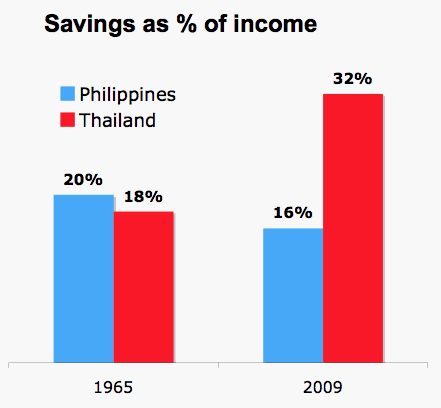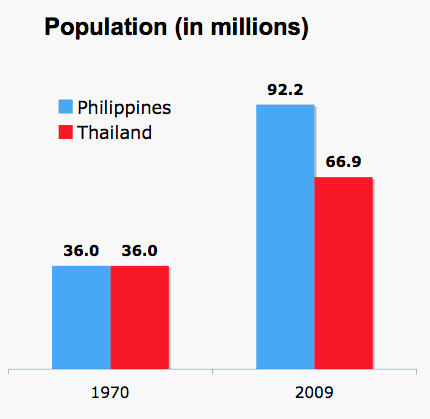 In his latest article “Divergent paths“, Inquirer.net columnist Cielito Habito shared some interesting statistics that provide breathtaking insight into the divergence of the fortunes of what were once the “virtual identical twins” that the Philippines and Thailand were back in 1970, that made the two countries the “estranged twins” that they are today. The divergence over the last several decades is made even more stark by using pictures to illustrate the statistics that Habito exhibits in his article. Indeed, the story can be told along three clearly stark points…
In his latest article “Divergent paths“, Inquirer.net columnist Cielito Habito shared some interesting statistics that provide breathtaking insight into the divergence of the fortunes of what were once the “virtual identical twins” that the Philippines and Thailand were back in 1970, that made the two countries the “estranged twins” that they are today. The divergence over the last several decades is made even more stark by using pictures to illustrate the statistics that Habito exhibits in his article. Indeed, the story can be told along three clearly stark points…
* * *
Failure to industrialise
| SUPPORT INDEPENDENT SOCIAL COMMENTARY! Subscribe to our Substack community GRP Insider to receive by email our in-depth free weekly newsletter. Subscribe to our Substack newsletter, GRP Insider! Learn more |

Industrialization surged in Thailand, with industry’s output share nearly doubling to 43.3 percent; in the Philippines, it only inched up to 30.2 percent. Where we failed in industrialization, we made up for in services, whose share of the economy grew to a dominant 55 percent.
Failure to save and invest

The Thais nearly doubled their saving rate to 32 percent, while ours fell to 16 percent. And average income (GDP per capita) in Thailand is now more than twice ours ($4,062 against our $1,796).
Failure to control population growth

[…] the contrast is now so dramatic, it’s downright depressing. In 2009, the Philippine population was 92.2 million, against Thailand’s 66.9 million. Our population now exceeds that of Thailand by more than the entire population of Mindanao. Filipinos are growing in number by about 2 percent per year, while the Thais are growing at less than half that pace, at 0.6 percent per year.
* * *
Thailand delivers knockout punches to the Philippines along the three key pillars of development: industrialisation, investment and savings, and population management. Perhaps it is the reason why Filipinos so badly wanted to see Manny Pacquiao win by knockout on television.
- This latest Filipino-style ‘anti-corruption’ circus proves that the Philippines needs a serious reboot - November 16, 2025
- Filipinos literal sitting ducks as wind and floods from natural tropical typhoons amplified by years of neglect bear down - November 9, 2025
- Rally NA NAMAN??? - September 20, 2025
Well, we all have the resources, we are content of being located smack dab in the middle of two growing regions…all we lack now is the capability to capitalize on what we all have. Unfortunately, the current leadership is either too clueless or too ignorant to realize this.
My guess is that by the time they realize it, there’ll be nothing left to capitalize on.
I second that we have bureucratic issues that haven’t been solved in our governmental procedures that made industrialization rates in the Philippines very slow. The current leadership role becomes too inefficient as caused by more paperworks less action SOPs in management and securing permits to launch a business.
Ah, but the Philippines has industrialized, as seen in the population figures. It manufactures little male and female products for shipment abroad. It buffs them up for a few years, boxes them, and ships them off to Dubai, Canada, the US, and all sorts of places. Add the inflow of income from these export products – never would I refer to them as servants; they are products – and the comparison rights up nicely. The problem is in the economic accounting. Everything is hunky dory here, no problem.
Pilipinas parang Bangladesh!
For the last half century, the Philippines generates its income by withdrawing from principal.
Should we blame the retarded mental evolution of the population for this failure? Apparently most people are worried about celebrities and politicians obtaining financial fornications deals instead of themselves.
About Manny Pacquiao
To be a complete world boxing champion, he needs to lead by example by complying with an example of his blood to the Nevada Boxing Commission, that way it will clear his name from the suspicion of usage of Illegal enhance drugs. MAYWEATHER all ready did it many times before.